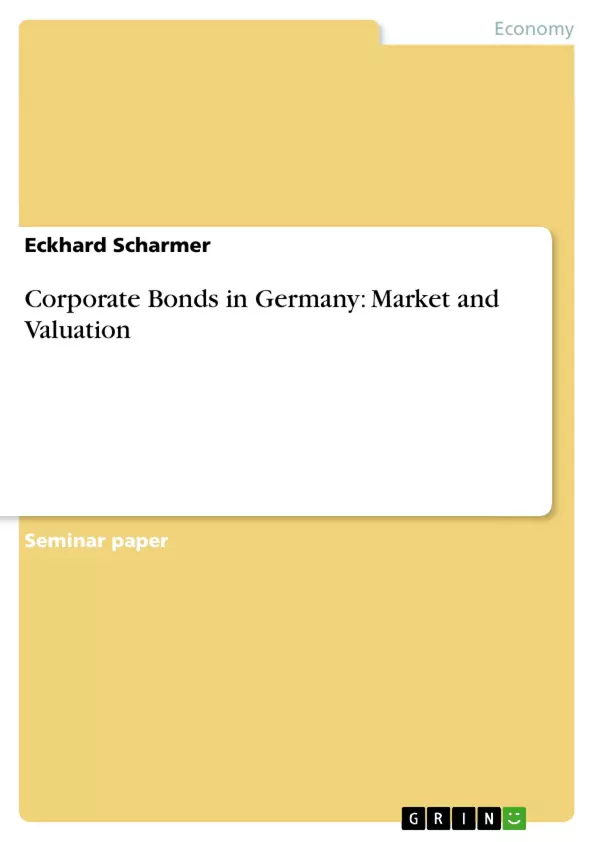The German corporate bond market is, like many other markets, subject to a constant development: New external conditions and changes in our economic environment always trigger new trends that can be observed when analysing the structure of capital markets. Particularly during the last months, a new significant tendency could be observed in Germany: As market statistics indicate, more and more German corporations decide to issue equity-linked securities such as convertible bonds instead of raising capital using straight corporate bonds or equity. Consequently, investors are now faced with a new asset class beyond debt, cash or equity. This implies more opportunities but also bears some risks, problems and pitfalls as each convertible has specific characteristics and covenants which have to be taken into account by the investor. The purpose of this study is to reveal the reasoning behind the growing popularity of convertibles within the German corporate bond landscape. In this context, the consequences and opportunities for the investor are emphasized as the paper shows how asset managers can benefit from the particular characteristics of convertibles. Moreover, the price reaction of the underlying share price on an announcement of a convertible issue will be analysed. In order to avoid a too theoretical approach, two extraordinary equitylinked issues that took place in Germany in 2003 are discussed and compared.
Inhaltsverzeichnis (Table of Contents)
- Introduction
- Nature of the Problem and Objectives of the Study
- Methodology and Structure
- The German Corporate Bond Market
- Historical Development of the German Corporate Bond Market
- Recent Trends in the German Corporate Bond Market
- Convertible Bonds: Alternative for Asset Managers?
- The Main Characteristics and Functionality of Convertible Bonds
- The Valuation of Convertible Bonds
- Convertibles as an Asset Class for Portfolio Managers
- Case Study 1: The Mandatory of Deutsche Telekom AG
- Background and Conditions of the Issue
- The Mandatory Convertible from the Issuer's perspective
- The Mandatory Convertible from the Investor's perspective
- Case Study 2: The Exchangeable of KfW
- Key Facts of the Issue
- Reasoning behind the Deal
- Benefits for the Investor
- Market Reaction on Announcement
- Conclusion and Outlook
Zielsetzung und Themenschwerpunkte (Objectives and Key Themes)
This study aims to investigate the growing popularity of convertible bonds within the German corporate bond market. It examines the reasoning behind this trend, the consequences and opportunities for investors, and the potential benefits for asset managers. Additionally, the paper analyzes the price reaction of underlying share prices following the announcement of convertible issuance. Two specific case studies are presented to illustrate the rationale behind convertible issuance from both the issuer's and investor's perspective.
- The growing popularity of convertible bonds in the German corporate bond market
- The impact of convertible bonds on investors and asset managers
- The price reaction of underlying share prices to convertible issuance announcements
- Analysis of the rationale behind convertible issuance from both the issuer's and investor's perspective
- Case studies on specific convertible bonds in Germany
Zusammenfassung der Kapitel (Chapter Summaries)
- Introduction: The study begins by introducing the German corporate bond market, highlighting its ongoing development and the growing trend of corporations issuing equity-linked securities like convertible bonds. It outlines the objectives and methodology of the study, emphasizing the analysis of investor opportunities and the price reaction to convertible issuance announcements.
- The German Corporate Bond Market: This chapter delves into the historical development and recent trends of the German corporate bond market, providing context for the emergence of convertible bonds as an alternative investment class. The chapter analyzes the market's structure and the shift towards equity-linked securities.
- Convertible Bonds: Alternative for Asset Managers?: This chapter explains the functionality and core features of convertible bonds, crucial for understanding the subsequent case studies. It also explores the potential of convertibles as an asset class for portfolio managers and investors.
- Case Study 1: The Mandatory of Deutsche Telekom AG: This case study examines a specific example of a mandatory convertible bond issued by Deutsche Telekom AG. It analyzes the issue's background, conditions, and implications for both the issuer and investor. The chapter discusses the investor's perspective on the mandatory convertible.
- Case Study 2: The Exchangeable of KfW: The second case study analyzes an exchangeable bond issued by KfW, which can be exchanged into shares of Deutsche Telekom AG. This chapter explores the key facts, reasoning behind the deal, benefits for the investor, and the market reaction to the announcement of the exchangeable bond issuance.
Schlüsselwörter (Keywords)
The study focuses on the following keywords: German corporate bond market, convertible bonds, equity-linked securities, asset management, investor opportunities, price reaction, mandatory convertible, exchangeable bond, Deutsche Telekom AG, KfW, case studies.
- Citar trabajo
- Eckhard Scharmer (Autor), 2003, Corporate Bonds in Germany: Market and Valuation, Múnich, GRIN Verlag, https://www.grin.com/document/22591



